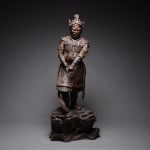Sculpture Of A Guardian, 1644 CE - 1912 CE
Bronze
height 109.2 cm
height 43 in
height 43 in
PF.6170
Further images
The Ch'ing Dynasty was established by the Manchus, who invaded China and captured Beijing in 1644. The term Ch'ing means “pure,” and was used to add legitimacy to foreign rulers....
The Ch'ing Dynasty was established by the Manchus, who invaded China and captured Beijing in 1644. The term Ch'ing means “pure,” and was used to add legitimacy to foreign rulers. The Manchus adopted many aspects of Chinese culture, won widespread Chinese collaboration, were the last Imperial rulers of China. This sculpture depicts a characteristic representation of a guardian. Originally, such figures were based in Buddhist beliefs and were known alternately as a Lokapala and a Devaraja, or Celestial King. However, as time progressed, such figures lost their religious significance and became more generic tomb guardians. This gorgeous bronze sculpture of a guardian warrior is stunning for its intricate details and powerful expression. The guardian stands upon a rocky outcropping, his posture related to the traditional pose of the Lokapala who stood upon a recumbent ox or subdued demon. He wears a set of protective platted armor, fabulously rendered and decorated with inlaid glass. At one time, he would have held a weapon of sorts, perhaps a spear or halberd. His hair has been styled in a bun at the top of his head. He wears a tiara, crowned by a small bird, perhaps a phoenix. This impressive sculpture reveals the consistency of Chinese art throughout its history. This type of figure had been created for well over fifteen hundred years to protect against the unseen forces of evil. Although the Manchus were a foreign dynasty, they were careful to retain the traditional forms and styles of Chinese art as this sculpture reveals.





